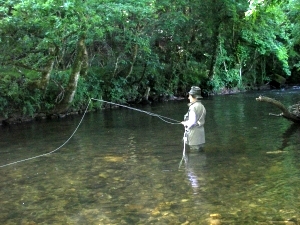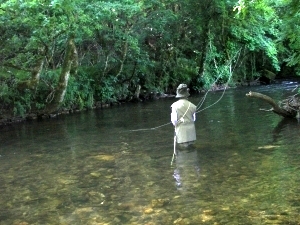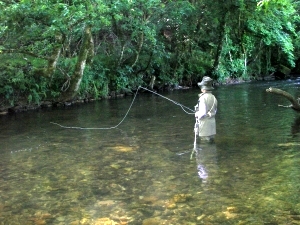 |
 |
 |
 |
 |
 |
|
Home page About us Instruction Guiding Locations map Gift vouchers Prices Articles Contact us Accommodation Links |
 |
One problem
with overhead
casting is that our flies inevitably get caught in trees and
bankside vegetation. This can be particularly frustrating on our
small tree-lined westcountry rivers. Therefore as guides and
instructors we place a great deal of emphasis on teaching our clients to roll cast. For beginners teaching the roll cast takes place on small stillwaters with little in the way of bankside obstructions. But many people - who have mastered the 'static' roll cast - then have a rude shock when confronted with a river for the first time. Dealing with swirling currents and overhanging trees is difficult. They also quickly discover that the roll cast has one fundamental weakness. The basic roll cast is not an efficient way to make large changes in the position of the flyline on the water. Here are some suggestions for overcoming these obstacles. These involve adapting some of the techniques developed in other branches of fly fishing - in particular the family of casts referred to as Spey casts. |
 "Spey
Casting"
"Spey
Casting"Spey casting was developed to cope with situations where room to make a back cast is restricted by bankside vegetation.
Spey casts also allow the angler to make large changes in the position of the flyline on the water.
It is possible to Spey cast using single-handed trout rods. However, Spey casting was developed to meet the needs of salmon anglers who typically:
- use a sunk or 'wet' fly
- cast downstream and across
- present a dry fly
- cast upstream and across
The page assumes that the reader has a working knowledge of Spey casts.
"Problems and Principles"
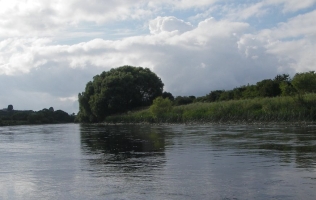
Conventional Spey casting is associated with salmon anglers wielding long two-handed rods on wide rivers.
Efficient Spey casting is based on several key principles:
- avoid slack line during the cast
- create a 'D' or '>' loop between the rod tip and the end of the line ('anchor' point) lying on the water
- the anchor point should be in line with the target
- according to the the 180 degree rule, the anchor point, D-loop and forward cast should all be in a straight line
However Spey casts involve complications which distinguish them from the basic roll cast:
- The rod remains loaded throughout the cast
- The fly line and rod are under 'tension' throughout the cast
- the 'anchor' makes only brief contact with the water
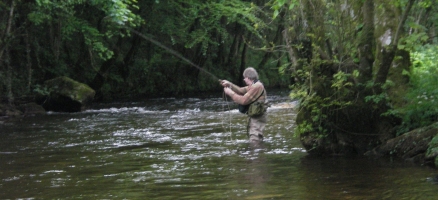 "Skagit
casting"
"Skagit
casting"A new type of Spey casting -called Skagit - has been developed for steelhead fishing in the Pacific North West of America. It is fundamentally different in important ways from traditional Spey casting:
- The rod does not remains loaded throughout the cast
- The fly line and rod are not under 'tension' throughout the cast
- the anchor is allowed to come to rest on the water; the so-called 'waterborne anchor'
Nevertheless, using Skagit or Spey-type casts to cast a dry fly upstream to trout on a small river presents a number of new challenges:
- the fly line is swept back downstream towards the angler. This produce curves in the line. This slack causes a loss of 'tension' in the line at the start of the cast
- the dry fly may become waterlogged as the angler drags the line across the water surface to set up the 'D' loop before making the forward cast
- on a narrow river, short casts with only 10-20 feet of fly line may not 'load' the rod sufficiently to produce an effective forward cast
"First steps upstream"
We have borowed ideas from Spey and Skagit casting to address these issues:
- the concept of a 'waterborne anchor' from Skagit (here is a glossary of terms)
- the 180 degree principle from Spey
- We use the phrase 'line parking area' to describe an area of relatively shallow, slow moving and often unproductive water lying alongside an area of deeper water which holds trout.
- Because the current is slow moving you can safely 'park' the line here whilst your take a few upstream steps as you progressively fish up a pool.
- The 'line parking area' is also used to set up the 'waterborne anchor' prior to the forward casting stroke
 |
 |
| These
pictures were taken from the
perspective of an angler looking upstream. An area of deeper
water beneath the bank on the left holds good-sized trout. The
area of shallower and relatively slower moving water on the right
holds few fish. The next two pictures show - from the angler's perspective - the position of the fly line in the parking area and after it has been cast into the fish-holding area. |
|
 |
 |
| The fly line has been extended into the line parking area ... | then the fly is cast into the fish holding area |
| The line parking area can be used to 'park' the fly line as the angler slowly works upstream. This avoids the problem of the fly line being swept downstream which inevitably leads to a waterlogged dry fly. | |
|
It turns out that the 'line parking area' can be used to overcome the other problems associated with using Spey-type casts to deliver a dry fly upstream. |
|
The line parking area can be used for several
purposes,
to:
Perform these preparations prior to delivering the fly into a fish holding area. Try to avoid making unnecessary casts into the 'fish holding area'. Often the first drift through the 'fish holding area' is the most successful at eliciting a rise from trout. Excessive casting into the holding area can spook fish. |
 |
| When making
a roll or Spey-type cast
to send the fly from the line parking area into the fish holding
area avoid waterlogging the fly by dragging it through the
water. I find that lifting as much line off the water prior to
sweeping the rod downstream to position the 'anchor
point' keeps the fly dry. This downstream sweeping movement is similar to the 'Pirouette' in Spey casting. Think of the fly as a ballet dancer on tip-toes lightly moving lightly across the surface of the water.
Try to avoid pausing too long after you have formed the 'D' loop and before making your forward cast. The current will move the fly line towards you. This removes tension from the line and creates curves in your line which reduce the efficiency of your forward cast. To overcome these problems slide the line towards you faster than the speed of the current. |
|
|
|
|
 |
 |
| Of course the fish holding area may be on your right as you move upstream. These two pictures show the relative position of the two areas when the fish holding area is located on the angler's right hand side. Make sure to carefully position the anchor point so that it points at the target before making the forward cast. Do not make your forward cast over and across the fly line. Failure to observe this simple point will result in a crossed line which tangles the fly and leader. | |
|
|
|
| At the end of the drift the fly line ends here ... | ...and must be positioned in the line parking area before being cast again into the fish holding area. The Snake Roll is a good cast to use for this purpose. |
 |
 |
| As the fly
drifts downstream through
the fish-holding area, gently pull line through the rings to
maintain contact with the fly. Avoid jerky or long pulls that
could create unnatural drag on the fly. Then when you have
returned the fly line to the line parking area, shoot this
retrieved line into a roll cast before making your next cast into
the fish-holding area. In the restricted environment of a small river you may not be able to execute 'classic' Spey casts. Just remember the principles of Spey casting. Remember that the line will follow the path of the rod tip.
|
|
|
|
|
| "Get
out of jail"
cast Try to avoid letting the line and fly drifting too far downstream of your position. If you find that your line has drifted too far downstream, you can get it back to the line parking area by using Günter Feuerstein's up-stream pick up cast. You may find that your fly is now waterlogged and tends to sink. Dry your fly by making repeated roll casts into the line parking area. Overpower and use a 'hard stop' on the forward cast to drive water from your fly. This may cause your line to fall in curves. Simply make a roll cast to straighten the fly line before casting into the fish holding area. |
 |
|
|
|
| "Coping
with a tricky
situation" The next photographs illustrate a potentially tricky situation. The right-handed angler is casting upstream to fish that are lying to the left under a canopy of overhanging trees. The line is carried downstream on the angler's left hand side. The angler could make a roll cast over their left shoulder but there is a risk of getting caught in overhanging branches. One solution is to raise the rod as the line is carried downstream and then make a Snap-C or Snap-T cast to position the anchor point to the right of the angler. |
|
 |
 |
|
|
|
| "Proceed
upstream
carefully" The next two pictures illustrate a situation where good trout may be found (in area B) towards the head of a pool just upstream of a prime line parking area. You can often pick up a good fish by paying careful attention to your fly when you place it into a parking area for the first time. |
|
 |
 |
|
|
|
| "The
Downstream Line
Parking Area" As you reach the head of a pool you may find that the line parking area is now downstream of your position. You can still utilise the functionality of the parking area. At the end of the drift this right-handed angler can use a snake roll to place the line in the parking area, followed by a cast over their left shoulder to send the fly back to the fish holding area which runs along the opposite bank. |
|
 |
 |
| Of course
the idea of a
'downstream line parking area' is not new. Wet fly
anglers are advised to step downstream after the line
reaches the
dangle.
Teaching change of direction using a 'flop-and-stop' Skagit-style cast Sometimes it is easier to have anglers facing downstream when introducing them to the concept of the 'line parking area' and principles derived from Skagit and Spey casting. In this example the angler has been shown how to make a 'flop-and-stop' Skagit manoeuvre to reposition the flyline. The photographs below show a common problem faced by beginners fishing a wet fly 'down-and-across'. The angler wants to present her fly to fish lying under the trees on her right hand side. She cannot use an overhead or side cast because of vegetation behind her. A roll cast is the answer in this situation. However, once her line has swung around in the current and is hanging straight downstream, she will need to reposition the line so that she can make another cast beneath the trees. If she simply roll casts in the direction of the trees on her right the line will cross itself and tangle. The video clip shows how we have taught her to change the direction of her roll cast to deal with this dilemma. |
|
 |
 |
In order to
change the direction of her roll cast the angler:
|
|
|
|
||||||||||||
|
||||||||||||
|
|
||||||||||||
| "An
unresolved
problem" Earlier I pointed out that on a narrow river, short casts with only 10-20 feet of fly line may not 'load' the rod sufficiently to produce an effective forward cast. I have not given a satisfactory solution to this problem. Currently there is no straightforward solution. I contacted Bruce Richards - Chief Line Designer for 3M/Scientific Anglers - to seek his advice. Here is our exchange of emails on this issue: I am writing to
request help with
choosing a line to use when Spey casting with short single-handed
trout rods.
Bruce Richards replied as follows:I fish on small - often heavily bushed - rivers running off Dartmoor in the west of England. In American terms these would be classed as freestone creeks and rivers. Because these waters are relatively narrow, casts tend to be short (with a maximum of 20 feet of fly line outside the rod tip). I use a 7’9” AFTM#5 (Orvis ‘Far & Fine’). I have a suspicion that a 5 weight line is not loading the rod sufficiently for effective Spey casts. A simple solution might be to ‘overline’ the rod with an AFTM#6 line. But the thicker front taper could compromise presentation. My understanding - after reading the literature on Spey casts- is that weight needs to be concentrated in the belly that forms the ‘D loop’. I have a mental kinaesthetic 'image' of what I am looking for - the rod should feel partially loaded when I form the 'D' loop; I should be able to feel the weight of the belly dragging down the rod tip. One possibility would be to use one of your Skagit lines; after all the Skagit style was developed to deal with the conditions I encounter - restricted room for forming the 'D' loop. However - the 'Spey Skagit DeLuxe' AFTM#6 weight specification sheet indicates that the belly starts 19.5' from the tip because they are designed to be used for long casts with longer rods and 27' of line outside the rod tip. Do you market a range of lines with fine front tapers and relatively heavy bellies that would be suitable for short range Spey casts with short single handed rods? I guess this type of line may be in development given the increased interest in Spey casts Thanks for any help you can give. Paul Kenyon Mr. Kenyon,
Thank you for your inquiry. Your analysis of the line needed for single hand spey casting is correct. Typically when spey casting with single hand rods casters find that going up 2 line sizes gives the best result. In a couple of weeks we will be introducing a series of Skagit style lines specifically for use with standard single hand rods, but I don't think that is what you want. You indicate that presentation is still important, and most Skagit style lines are designed primarily for casting either with sinking tips, or a floating tip that is designed to throw weighted flies and indicators. If your goal is to fish dry flies with a reasonably delicate delivery a Skagit style line is probably not the right choice. I would suggest using a 7 wt. line with as delicate a front taper as possible. I would suggest a WF (or DT) -7-F Mastery Trout line. The extra weight of the 7 wt. belly will load your 5 wt. rod properly, and these lines are designed for dry fly fishing and will have as delicate a delivery as any 7 wt. you will find. I think you will find that this line would give you the best results for what you are trying to accomplish. If you have further questions please let me know. Regards, Bruce Scientific Anglers/3M A word of caution Note that Bruce Richards suggests using a Mastery Trout line which is "a 7 wt. line with as delicate a front taper as possible". Take care that you not overload the rod by trying to cast more than 20 feet of AFTM#7 fly line on a rod rated for AFTM#5. Also proceed with care if you use any other brand of line. Snowbee offer the following advice to help avoid rod breakage: Never use a fly line more than one line weight above the rod's rating. |
||||||||||||
